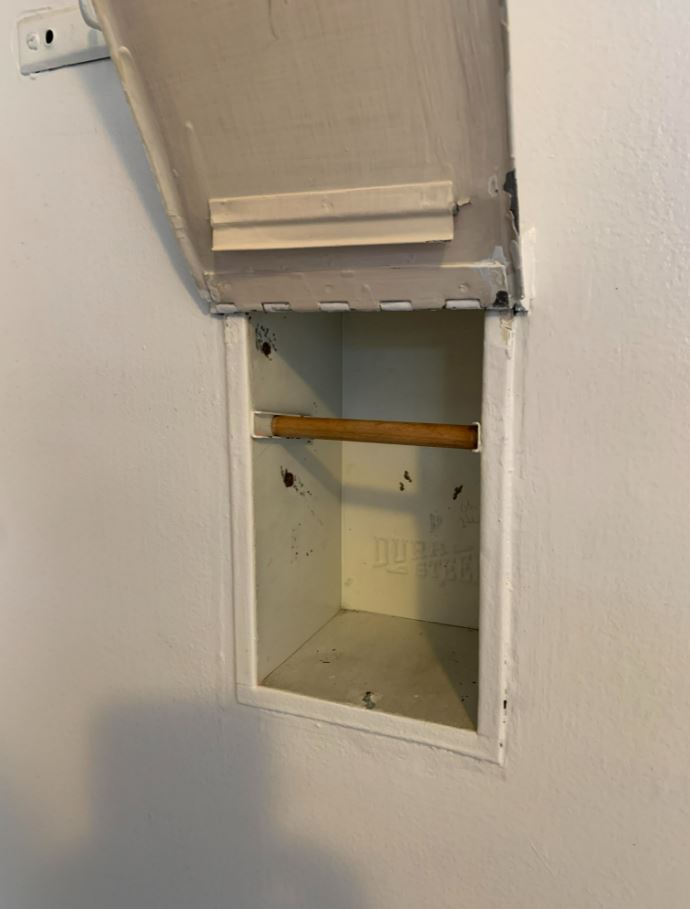Imagine walking into a 1930s-era home and stumbling across a small, unassuming door built right into the wall. You open it and find a recessed space inside, complete with a wooden dowel and perhaps some brackets or hinges. At first glance, it might seem like an odd architectural detail—something left over from a bygone time. But for those who know their way around vintage home design, this hidden nook reveals more than meets the eye. What you’ve found is likely a built-in ironing board cabinet, a once-common household feature that represents the ingenuity, practicality, and style of early 20th-century living.

During the 1930s, home design took a turn toward efficiency and smart use of space. Homemakers were juggling a growing number of tasks, and innovations in household layouts were making chores more manageable. Built-in features became popular across the country, with the goal of saving space while streamlining daily routines. Among these features, the recessed ironing board cabinet stood out. It was designed to house a full-sized ironing board that could be pulled down for use and folded back up when the task was done, all while staying out of the way and hidden behind a simple door.
Back then, ironing wasn’t an occasional task—it was a part of everyday life. Most clothing was made from natural materials like cotton and linen, which wrinkle easily and required frequent pressing. There were no wrinkle-free fabrics or steam dryers to make the job easier. So having an ironing board readily available—without having it constantly in the way—was a big deal. Unlike modern freestanding boards that take up closet space or lean awkwardly against a wall, these built-in boards were designed for convenience and practicality.
What makes these built-ins even more impressive is the level of thought and quality put into them. One of the most recognized manufacturers of these cabinets was Durasteel, a company well-known for its fire-resistant cladding and household fixtures. Their ironing board cabinets were made to last, constructed from sturdy materials that could withstand daily use. They were functional, but they also blended in with the rest of the home’s design, offering a seamless look that didn’t sacrifice form for function.
These built-in ironing board cabinets were especially popular in homes where space was at a premium, such as in Southern California. Instead of dedicating a separate area for laundry or ironing, homeowners could simply install a recessed cabinet in a kitchen, hallway, or near the laundry area. This allowed the person managing household chores—usually the homemaker—to access the board quickly, iron clothes, linens, or towels, and then neatly fold everything away without leaving any clutter behind. It was the kind of practical solution that made everyday tasks just a little more manageable.
If you ever come across one of these vintage cabinets, you might notice several classic features. Inside the recessed space, there’s often a dowel or bar used to support the ironing board or to hang towels or cloths. The door is usually hinged and sometimes latched to keep it closed when not in use. Some versions include small hooks or shelves inside the cabinet to hold ironing supplies like starch, water spray bottles, or clothespins. It’s a compact yet complete station tucked neatly out of sight—a testament to smart design and practical thinking.
Even today, as we navigate modern living with collapsible boards, high-tech irons, and steamers, there’s something charming—and still quite clever—about the built-in ironing board cabinet. It serves as a reminder that functional design doesn’t have to be flashy. In fact, some of the best ideas are the ones that quietly serve their purpose day in and day out. For those restoring old homes or simply appreciating vintage architecture, discovering one of these wall cabinets is like opening a window into the past—a small but meaningful glimpse into how previous generations lived, worked, and made the most of their space.
While modern homes focus heavily on open-concept layouts and high-tech conveniences, the built-in ironing board cabinet continues to be a symbol of a time when thoughtful design and everyday function went hand in hand. It may be hidden behind a modest door, but its legacy speaks volumes. It’s more than a quirky architectural feature—it’s a slice of domestic history and a tribute to smart, stylish, space-saving design.





